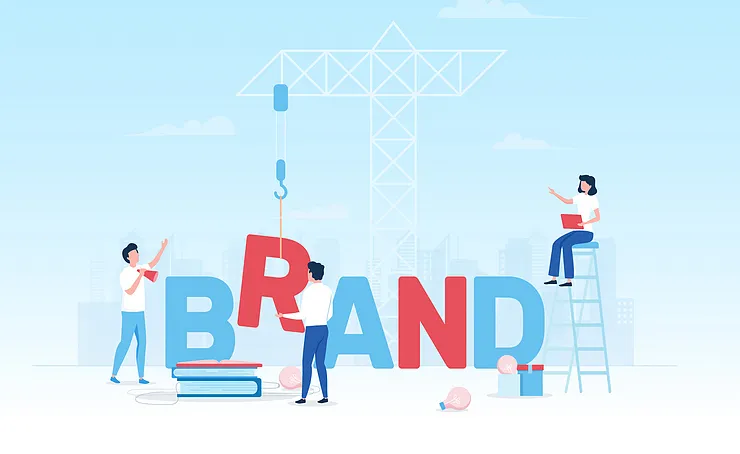Updated: September 2, 2023
Your brand is more than just a logo or a catchy tagline; it’s a multifaceted entity that needs a well-thought-out strategy to thrive. Whether you’re a startup aiming for a splashy launch or an established business looking to refresh your image, creating a brand involves several key steps that blend analytical thinking with creative execution.
This guide breaks down the essential phases—from initial assessment and planning to the comprehensive deployment of both digital and physical brand elements. We’ll walk you through the ins and outs, ensuring that by the end, you’re well-equipped to give your brand the solid foundation it deserves.
Step 1. Assess and Analyze
When it comes to branding, the first task at hand is a thorough assessment and analysis. Typically, a designer will ask the client to articulate their business goals and brand personality. One effective approach is asking clients to list 4 to 5 keywords that encapsulate their business.
Thorough market research is crucial here. According to DestinationCRM.com, effective data management can increase revenue by up to 66%. By meticulously gathering and analyzing data on target audiences and competitors, designers can set the stage for a successful brand strategy.
Step 2: Plan
Planning is the phase where all the information gathered is transformed into actionable strategies. This involves:
- Positioning your brand
- Developing a messaging strategy
- Developing various ideas for the business’s name, logo, tag line, and website.
- Developing your content marketing strategy
As reported by ahrefs.com, according to the Content Marketing Institute, 73% of B2B marketers and 70% of B2C marketers use content marketing as part of their overall marketing strategy.
Step 3: Design
Once planning is done, the next stage is design refinement and finalization. It’s a collaborative effort that benefits from a detailed discussion between the designer and the client. Topics like company perception, identity, and branding assets like logos and trademarks are decided upon here.
- Identity and branding assets e.g. logo designs and trademarks.
- How the company would be perceived as a result of the branding strategy.
- Layout variations for ensuring consistency in the design layout.
- The website design is finalized.
Step 4: Develop
Post-discussions and approvals, the design is translated into a functional website. This includes implementing the navigation structure, content management, and database.
According to LinkedIn, a study by Adobe found that 38% of people will stop engaging with a website if the layout is unattractive. Hence, development plays a key role in ensuring the website is as functional as it is visually appealing. Source
Step 5: Deploy
Deployment isn’t just about getting your website live; it’s about ensuring that every touchpoint of your brand is market-ready. This includes not just the digital aspects, but also the physical and legal elements that make your brand tangible and legitimate.
On the digital front, this stage includes final website tweaks, code testing, and validation of form functionalities. You’ll soft-launch your site, closely monitoring performance metrics and SEO elements. Remember, website speed matters. According to Google’s PageSpeed Insights, a faster website can significantly boost your search ranking.
Yet, deployment goes beyond the pixels on a screen. Now is also the time to finalize your branded assets—everything from business cards and corporate collateral to internal documentation. Have your logos printed on stationery, create brand-consistent PowerPoint templates for internal presentations, and even update your legal documents, such as contracts and invoices, to reflect your new branding.
Speaking of legal aspects, don’t overlook the importance of having all your trademarks and copyrights in order. Making sure your intellectual property is legally secured can save you from potential disputes down the road.
Traditional marketing materials, such as brochures and banners, should also be prepared and printed, ready for distribution. The deployment stage is the moment where your brand truly becomes multi-dimensional, inhabiting both digital and physical spaces.
In essence, the deployment stage is when you fully materialize your brand into the world, offering a cohesive experience regardless of where or how someone interacts with it. It’s not just a digital or physical launch; it’s a comprehensive brand reveal that sets the stage for all your future marketing and operational activities. So when you hit ‘launch,’ you’re not just releasing a website; you’re launching an entire brand ecosystem.
The Role of Client in Branding
The clients should be involved in every step of branding. Some clients are reluctant, they prefer to send a brief to the designers and encourage them to do the rest. But if the designers and the clients collaborate at every step, amazing things happen.
Continuous involvement of the client during the process of brand design illuminates the designer. She might find some interesting stories about the product. She might find words for what her client is trying to say. She might find the unique selling proposition of her client.
If the client and the designer get under the skin of the brand together, it results in outstanding branding.
Key Takeaway
Great branding requires soul-searching, market evaluation, and meticulous planning. So, whether you’re considering a brand refresh or starting from scratch, investing in a systematic approach is a must.
When you’re ready to make that investment, why not schedule a Strategy Session with our Creative Director to explore our branding solutions?





